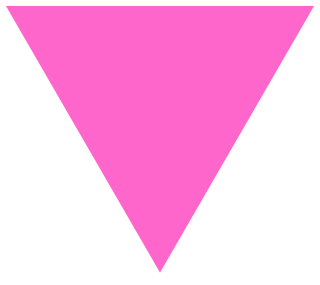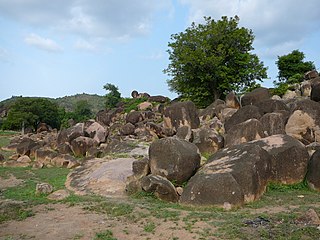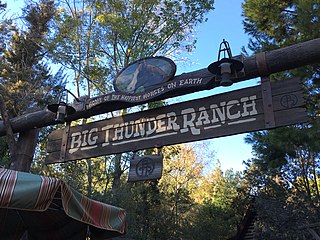
A pink triangle has been a symbol for the LGBT community, initially intended as a badge of shame, but later reappropriated as a positive symbol of self-identity. In Nazi Germany in the 1930s and 1940s, it began as one of the Nazi concentration camp badges, distinguishing those imprisoned because they had been identified by authorities as gay men or trans women. In the 1970s, it was revived as a symbol of protest against homophobia, and has since been adopted by the larger LGBT community as a popular symbol of LGBT pride and the LGBT movements and queer liberation movements.

An alligator, or colloquially gator, is a large reptile in the genus Alligator of the family Alligatoridae of the order Crocodilia. The two extant species are the American alligator and the Chinese alligator. Additionally, several extinct species of alligator are known from fossil remains. Alligators first appeared during the late Eocene epoch about 37 million years ago.

The saltwater crocodile is a crocodilian native to saltwater habitats, brackish wetlands and freshwater rivers from India's east coast across Southeast Asia and the Sundaic region to northern Australia and Micronesia. It has been listed as Least Concern on the IUCN Red List since 1996. It was hunted for its skin throughout its range up to the 1970s, and is threatened by illegal killing and habitat loss. It is regarded as dangerous to humans.

Bolgatanga, colloquially known as Bolga, is a town and the capital of the Bolgatanga Municipality and Upper East Region of Ghana, adjacent to the border with Burkina Faso. Bolgatanga has over 2012 settlements and a population of about 66,685 people. Bolgatanga is 161 km to the north of Tamale. Bolgatanga lies in the Red Volta River Valley, with the White Volta River and the cliffs of the Gambaga Escarpment to the south of the town forming the southern boundary of the Upper East Region./

The American crocodile is a species of crocodilian found in the Neotropics. It is the most widespread of the four extant species of crocodiles from the Americas, with populations present from South Florida, the Caribbean islands of Cuba, Jamaica, Hispaniola, and the coasts of Mexico to as far south as Peru, Ecuador, Colombia, and Venezuela.

The Upper East Region is located in northern part of Ghana and it is the third smallest of the 16 administrative regions in Ghana. It occupies a total land surface of 8,842 square kilometers or 2.7% of the total land area of Ghana. The regional capital is Bolgatanga, which is sometimes referred to as Bolga. Other major towns in the region include Navrongo, Paga, Sandema, Bawku, and Zebilla, Tempane, Pusiga, Garu, Pwalugu, Widana

Salaga is a town and is the capital of East Gonja district, a district in the Savannah Region of north Ghana. Salaga had a 2012 settlement population of 25,472 people. Salaga was the largest slave market in the 18th and 19th centuries.

The West African slender-snouted crocodile, or slender-snouted crocodile, is a critically endangered species of African crocodile. It is one of five species of crocodile in Africa, the other four being the Central African slender-snouted, Nile, West African and dwarf crocodiles.

Big Thunder Ranch was an attraction at Disneyland Park in Anaheim, California, United States. It included an outdoor petting zoo, a walk-through log cabin, and a variety of scenery meant to create the atmosphere of a Western ranch. It was located in Frontierland, nearby Big Thunder Mountain Railroad. Inside one could find sheep, goats, cows, and other farm animals. Among these animals were the two turkeys who received presidential pardons in honor of Thanksgiving in 2008. The attraction was hosted by Brawny.
A man-eater is an individual animal or being that preys on humans as a pattern of hunting behavior. This does not include the scavenging of corpses, a single attack born of opportunity or desperate hunger, or the incidental eating of a human that the animal has killed in self-defense. However, all three cases may habituate an animal to eating human flesh or to attacking humans, and may foster the development of man-eating behavior.

The railway stations in Ghana serve a rail network concentrated in the south of the country.

The goldfish is a freshwater fish in the family Cyprinidae of order Cypriniformes. It is commonly kept as a pet in indoor aquariums, and is one of the most popular aquarium fish. Goldfish released into the wild have become an invasive pest in parts of North America and Australia.

Mole National Park, one of Ghana's seven national parks, is the country's largest wildlife refuge. The park is located in the Savannah region of Ghana on savanna and riparian ecosystems at an elevation of 50 m, with a sharp escarpment forming the southern boundary of the park. The Park is 24 km from Damongo, the district capital, 146 km south east of Tamale, the Regional capital. The park is 700 km from Accra and 430 km from Kumasi. The park's entrance is reached through the nearby town of Larabanga. It covers an area of about 4,577 square kilometers of fairly undisturbed Guinea savannah in the northern part of Ghana. The Levi and Mole Rivers are ephemeral rivers flowing through the park, leaving behind only drinking holes during the long dry season. This area of Ghana receives over 10 mm per year of rainfall. A long-term study has been done on Mole National Park to understand the impact of human hunters on the animals in the preserve.

Shama District is one of the fourteen districts in Western Region, Ghana. Originally it was formerly part of the then-larger Shama Ahanta East Metropolitan District in 1988, which was created from the former Sekondi Takoradi Metropolitan Authority Council, until the eastern part of the district was split off to create Shama District on 29 February 2008; thus the remaining part has been renamed as Sekondi Takoradi Metropolitan District. The district assembly is located in the southeast part of Western Region and has Shama as its capital town.

Kassena-Nankana West District is one of the fifteen districts in Upper East Region, Ghana. Originally, it was formerly part of the then-larger Kassena-Nankana District in 1988, until the western part of the district was split off to create Kassena-Nankana West District on 29 February 2008; thus the remaining part has been renamed as Kassena-Nankana East District. The district assembly is located in the western part of Upper East Region and has Paga as its capital town.

Paga Crocodile Pond is a sacred pond in Paga in the Upper East Region of Ghana, which is inhabited by West African crocodiles. Due to the friendliness of the reptiles, it has become popular among tourists and the pond is now reliant on tourism to ensure the population of crocodiles remain fed and healthy. It is also known as Chief's pond.
Tourism in Ghana is regulated by the Ministry of Tourism, Arts & Culture. This ministry is responsible for the development and promotion of tourism related activities in Ghana.
Daniel Annor Walker is a Ghanaian football coach who currently coaches the Accra Great Olympics and the Ghana A' national football team. He previously coached Ghanaian teams; Nania FC, Kpando Hearts of Lions and Berekum Chelsea.
The 2021 Ghanaian FA Cup is the 41st edition of the Ghanaian FA Cup, the knockout football competition of Ghana.
The Assin Manso Ancestral Slave River also called Nnonkonsuo or Donkor Nsuo (singular) was one of the slave markets for gathering indigenes during the trans-Atlantic slave trade. It is located in the Central Region of Ghana, forty (40) kilometers along the Cape Coast-Kumasi highway.

















